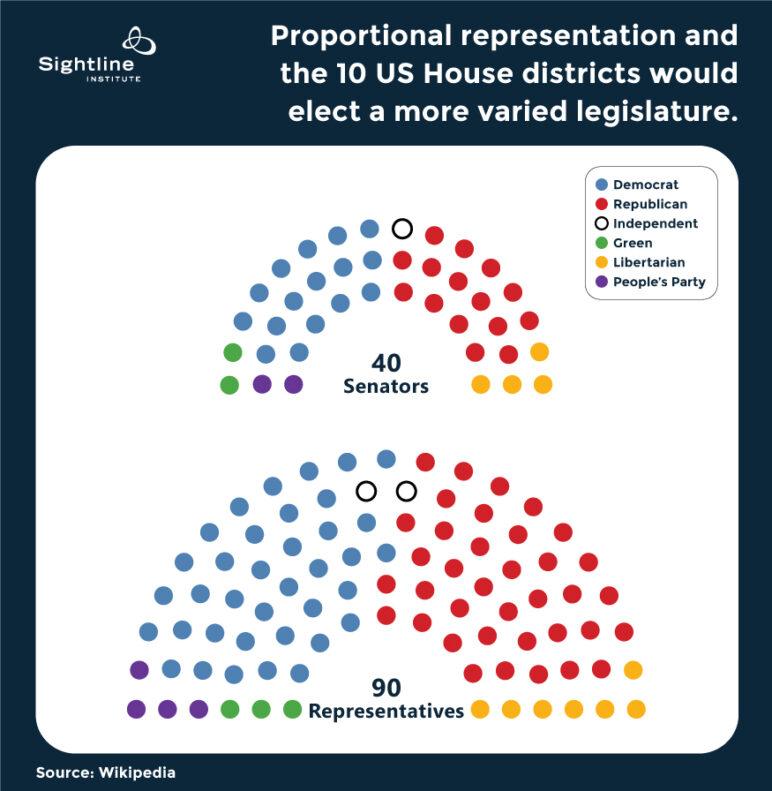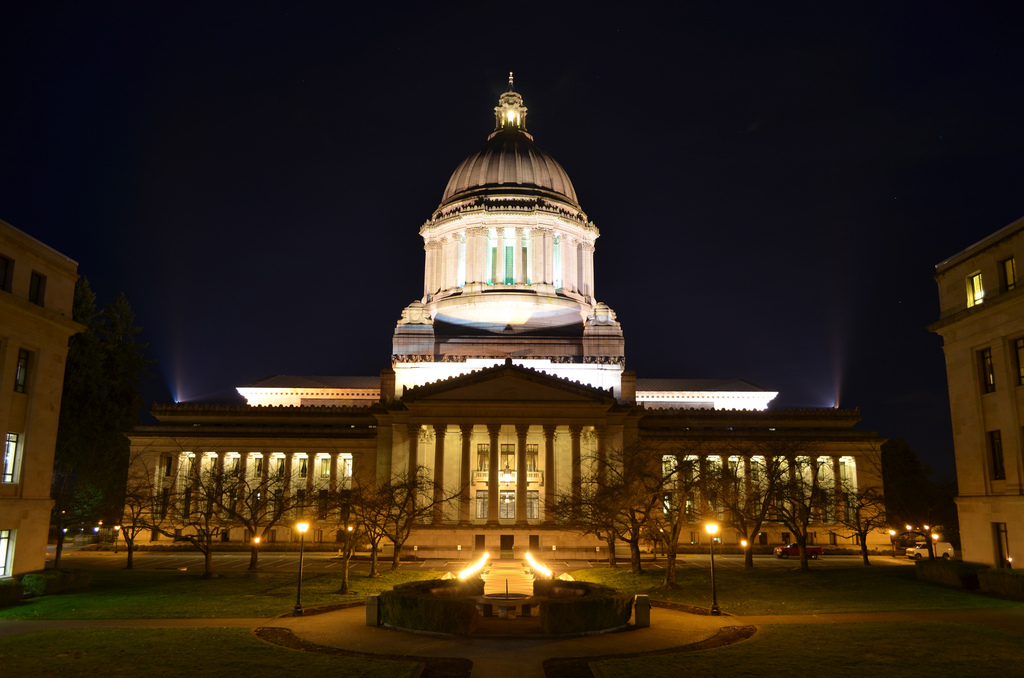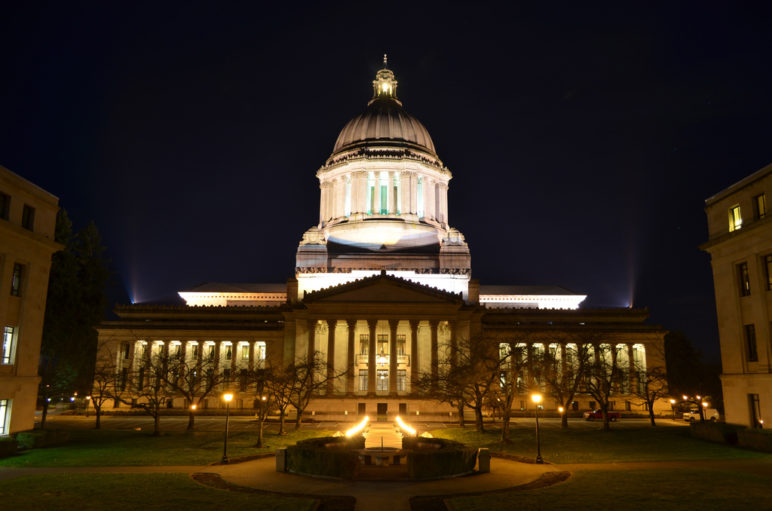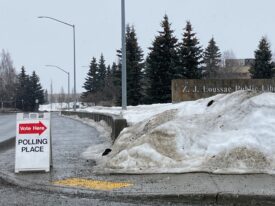This second option simplifies the redistricting commission’s job by using Washington’s ten US Congressional districts as its state legislative super-districts.
As the introduction to this series explained, the Washington state legislature is not as representative of the voters as it could be, and the state has four options for shifting to proportional representation. Proportional representation could give voters more voice, give candidates outside the two parties a shot, ease partisan gridlock, reduce the power of gerrymandering, limit the outsize influence of special interests, and make campaigns less expensive.
Last time, I described the first option: merge existing districts into 13 super-districts (or draw 14 new ones) and elect legislators through multi-winner races using a proportional electoral method such as ranked-choice voting. This second option simplifies the redistricting commission’s job by using Washington’s ten US Congressional districts as its state legislative super-districts. Like the first option’s 13-district plan, this option could be enacted by a citizen’s initiative and would not have to wait for the redistricting commission to draw new lines.
Elect four senators and nine representatives from each existing congressional district
Each of Washington’s ten existing US congressional districts could elect four state senators and nine state representatives, for a total of 40 senators and 90 representatives in the state legislature. This option would lead to a smaller legislature—130 instead of the current 147—but would be slightly more proportional than Option #1 because it would elect more representatives per district.
Citizens could vote to implement this reform without drawing new districts because it would use the current lines. The map below shows the current US congressional districts, though the state’s redistricting commission will redraw them in 2021.

Original Sightline Institute graphic, available under our free use policy.
Voters might like the idea of a slimmer but fairer state legislature. Although the redistricting commission could still intentionally or unintentionally gerrymander US congressional districts, its decisions to keep a particular neighborhood in or out of a district wouldn’t have as much impact on state legislative elections where voters’ behavior and election results would become more nuanced that Red vs Blue and Win vs Lose. Both houses overall would more fairly represent the voters in terms of their split between Democrats and Republicans, and would likely elect some Libertarians and Green Party members, and true independents. The figure below illustrates what a more proportional legislature might look like, but it doesn’t purport to predict how voters and candidates would actually respond to this option.

Original Sightline Institute graphic, available under our free use policy.
Because each district would elect more candidates and the proportional voting system would allow candidates outside the two major parties, voters would see more choices on the ballot. They might be able to rank those candidates in order of preference on a ballot like this:

Original Sightline Institute graphic, available under our free use policy.
Advances in vote-counting equipment may soon allow for voters to write in their rankings on a ballot like this:

Original Sightline Institute graphic, available under our free use policy.
Alternatively, Washington voters might want to adopt a simpler ballot that still achieves proportional results, for example with a method like the one I described here, though that particular form of voting would need some real-world experience.
Representatives would need the same number of votes and Senators would need twice as many
As explained in Option #1, it wouldn’t necessarily be harder for candidates to run in super-districts. Assuming the same voter turnout as now (around 70,000 Washingtonians cast votes in each of the 49 current districts), in super-districts electing nine representatives and four senators each, representatives would still need to reach the same number of voters while senators would need to reach twice as many voters. However, they could draw those voters from across a more populous district, so senators would only need to win 20 percent of the vote in the larger district rather than 50 percent in the smaller district.

Original Sightline Institute graphic, available under our free use policy.
Using congressional districts as state super-districts would achieve fairer representation in the state legislature
By using the existing US Congressional districts and a proportional voting method, Washington could achieve proportional representation without a constitutional amendment. The change would give voters more choice and more voice, help break through partisan gridlock, defang the gerrymander, give voters the chance to limit special interests’ influence, and give candidates a viable chance at winning a seat even without the backing of one of the two major parties or big donors.











RDPence
Article II, Sec. 6 of the Washington state constitution says that senators shall be elected from single districts, so it appears that a constitutional amendment would be necessary to enable multi-member senate districts.
I am doubtful that PR would “ease partisan gridlock” as the writer suggests. Even a handful of minor-party or no-party legislators could deny a majority to either major party, thereby exacerbating gridlock.
Parker Friedland
Um…
STV is kinda a pain to count, and it increases the ballot spoilage rate. Perhaps proportional approval voting should be used instead. It’s not as much of a nightmare to count as STV and Harmonic voting are, overvotes aren’t even a thing in Proportional Approval Voting, and it’s also based on (what I believe to be) a significantly better single-winner method as well.
Based off of your previous clashes with approval voting advocates, I doubt you will agree with me, but even if you believe that STV is better then PAV, it’s undeniable that it would be much easier to implement PAV then STV. With PAV, the opposition can’t use fears about ballot spoilage rates against you, and you would also significantly cut implementation costs because, in PAV, you only need to conduct a fraction of the rounds of counting as you would need to with STV (unless you are planning to upload STV results into computers which I do not recommend). PAV isn’t the best PR multi-winner voting method (Harmonic voting is: scorevoting.net/QualityMulti.html) but it is by far the most pragmatic one.
Just in case you’ve never heard of PAV before:
https://www.youtube.com/watch?v=Gnsgo3z8UIg